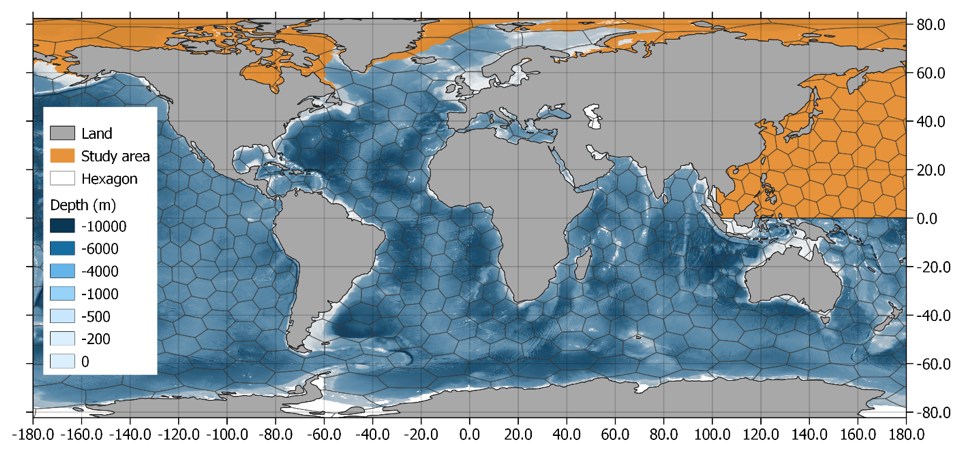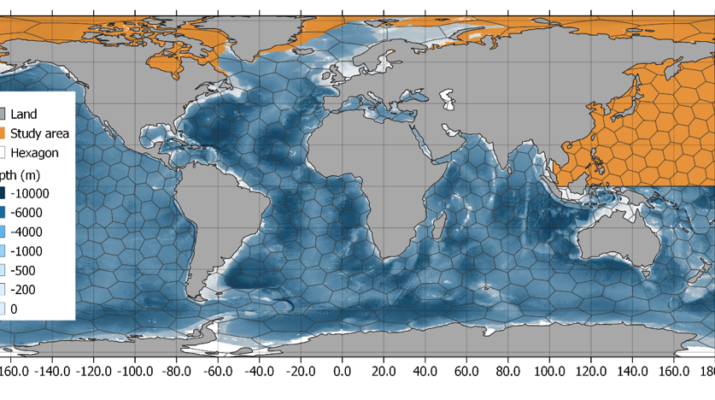[From Deep-Sea Life 16]
Chhaya CHAUDHARY1,2, Joan M. ALFARO-LUCAS1,2, Angelika BRANDT1,2, Hanieh SAEEDI1,2,3
1Department of Marine Zoology, Senckenberg Research Institute, Frankfurt am Main, Germany
2Goethe University Frankfurt, Biosciences, Institute of Ecology, Evolution and Diversity, Frankfurt am Main, Germany
3OBIS Data Manager, Deep-Sea Node, Frankfurt am Main, Germany
The biodiversity patterns, including species’ composition and distribution range changes, of marine fauna along the NW Pacific and the Arctic Ocean (AO) are still controversial and under-studied. Also, these regions, especially the AO, are reported to warm faster than the other oceans. Whether the species here are expanding their range towards the higher or the lower latitudes as a response to climate change, is also ambiguous. In the Beneficial project (Saeedi and Brandt, 2020; Saeedi et al., 2019a; Saeedi et al., 2019b; Saeedi et al., 2020), we have shed light on the biodiversity patterns and biogeography of a wide range of marine species from the NW Pacific to the adjacent AO, and from shallow water to deep sea. In the extension of the Beneficial project (2020-2021), we will further explore the patterns of biodiversity and biogeography in the AO using data available from OBIS and GBIF, and compare them with the patterns found in the NW Pacific (Figure 1). The main goals of the extension of the Beneficial project are to understand the current patterns of biodiversity and their drivers in the entire AO, and to model future species distribution of key taxa to understand the potential future direction, and expansion or contraction of species spatial ranges.

Specifically, using over 600,000 distribution records of over 19,000 species of the NW Pacific and the AO, we aim to analyze latitudinal and depth gradients in species richness and their compositional change (β-diversity)We will divide the broad study area to 10,000 km2 equal-area hexagonal cells and 5-degree latitudinal bands and will be using Generalized Additive Models (GAMs) and Generalized Linear Models (GLMs) to explore the relationship between the environmental drivers and species richness estimations along the AO in comparison with the NW Pacific. The β-diversity will be decomposed into turnover and nestedness components to shed light on the species compositional change patterns and identify β-diversity breakpoints within and between both oceans.
Furthermore, we aim to explore the distribution of 22 species of corals and 144 species ecologically associated with them. The associated species are selected based on their biological association identified with corals in literature, and their spatial overlap with the coral species. The main focus of these analyses is to explore the current and future distribution of these species in RCP45 and RCP85 IPCC scenarios, using species distribution modelling based on environmental variables including temperature, current velocity and salinity from Bio-ORACLE. We will then compare the maximum latitudinal extent of the species range in the current and future scenarios. The difference would reveal the direction of range shift in these species; also if the species are showing poleward expansion or retraction.
Overall this project will help to understand the nuances of diversity patterns of the shallow and deep-sea fauna of the NW Pacific and the AO constituting a valuable baseline to decision makers and initiatives to better manage and preserve the future biodiversity of the NW Pacific and the AO under the current rapid climate change.
References
Saeedi, Hanieh and Angelika Brandt 2020. Biogeographic Atlas of the Deep NW Pacific Fauna. Advanced Books 1. doi: http://doi.org/10.3897/ab.e51315
Saeedi, Hanieh, Mark J. Costello, Dan Warren and Angelika Brandt 2019a. Latitudinal and bathymetrical species richness patterns in the NW Pacific and adjacent Arctic Ocean. Scientific Reports 9: 9303. doi: http://doi.org/10.1038/s41598-019-45813-9
Saeedi, Hanieh, Marianna Simões and Angelika Brandt 2020. Biodiversity and distribution patterns of deep-sea fauna along the temperate NW Pacific. Progress in Oceanography 183: 102296. doi: https://doi.org/10.1016/j.pocean.2020.102296
Saeedi, Hanieh, Marianna Simões and Angelika Brandt 2019b. Endemicity and community composition of marine species along the NW Pacific and the adjacent Arctic Ocean. Progress in Oceanography 178: 102199. doi: https://doi.org/10.1016/j.pocean.2019.102199

